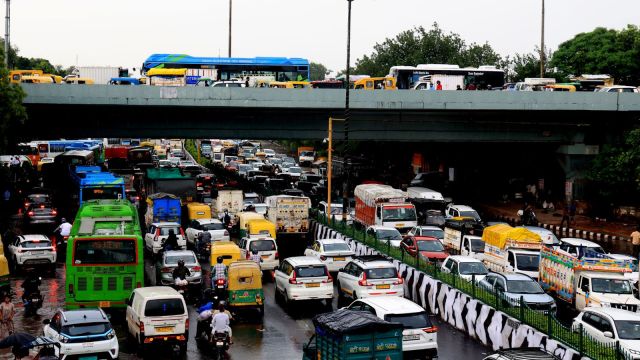Tired of being stuck in traffic? Why Capital’s roads are always congested
Six in ten daily trips in the Capital, the study points out, are under 4 km, yet long-haul buses continue to dominate the city’s network. The report also states that 80% of the trips are less than 6 km
 Traffic gridlock at ISBT in New Delhi (File Photo)
Traffic gridlock at ISBT in New Delhi (File Photo)At the start of September, there was a nearly 8-hour-long jam along the Delhi-Gurgaon border. Choked roads and bumper-to-bumper traffic left thousands of commuters stuck due to the rain-triggered traffic gridlock. Some even vented their frustration on social media, claiming that it was a 10-km-long traffic jam. Shortly after, visuals flooded the internet.
However, it is common for the Delhi-Gurgaon border to get congested — sometimes for hours at a stretch, leaving commuters fuming.
After 16-lane roads get choked, people are unable to get out and leave, even if they want to. A stretch of a few kilometres takes hours to cover.
This is the situation at any of the approximately 200 traffic choke points across the Capital. Auto-rickshaws, cars, buses and in some instances, trucks are trying to get ahead of the vehicle in front of them as commutes turn into an endurance test, especially during peak traffic hours.
Why are Delhi’s roads congested?
An April 2025 study titled ‘Neighborhood public transit services: Situational analysis of bus-based public transport supply in Delhi’ by The International Council on Clean Transportation (ICCT) pins Delhi’s traffic woes on a misalignment of the city’s public transport with the short-distance travel needs of its citizens.

Six in ten daily trips in the Capital, the study points out, are under 4 km, yet long-haul buses continue to dominate the city’s network. The report also states that 80% of the trips are less than 6 km.
While Delhi Metro’s 288 stations span 395 km and recorded over 8 million daily trips in August this year, the report shines light on why this won’t be enough to contain the traffic on the road.
“The deployment of short-distance, high-frequency transit services is a potential solution that directly addresses these gaps. Such services would focus on enhancing intrazonal connectivity by providing frequent and reliable transportation options within smaller, more localised areas. This, along with improving access to public transit in underserved regions, would also promote more efficient movement within densely populated urban zones,” the study underlines.
It also highlights that 31% of urban neighbourhoods in Delhi fall outside a 500-metre radius of a public bus stop, a threshold recognised as the standard for walkable access.
“Nearly one-third of Delhi’s urban area lacks convenient access to formal bus service. For thousands of residents, daily mobility often involves long walks or costly last-mile connections — conditions that discourage public transport use and contribute to congestion and pollution,” it reads.
A 2016 report on decongesting traffic in Delhi by the Ministry of Urban Development had identified that the city’s reliance on private vehicles had increased due to the lack of accessible infrastructure for public transport. During that time, just 25% of the population was using private vehicles for commuting.
Growing use of private transport
The city’s population in 2001 was around 14 million. In 2011, this jumped to 16.8 million. Today, it is estimated to have crossed 30 million.
At the same time, the trips increased from 118 lakh in 2001 to 144 lakh in 2008. This figure was just 44 lakhs in 1981.
In 2005-06, the city had 48 lakh registered vehicles. The number went up every year and touched 1.2 crore in 2020-21. According to a May 2017 report titled ‘Rapid Assessment of Travel Patterns in Delhi’, this figure could further jump to over 2.7 crores by 2050.
From 1981, the number of registered vehicles has grown by a factor of 20, while the population has grown by five times and the road length has doubled.
“The transportation network in Delhi is predominantly road based with 1,284 km of road per 100 sq.km. The total road length (km. lane) which was 14,316 km in 1981 which increased to 28,508 km in 2001 and 31,373 km in 2009 respectively,” according to the May 2017 study by School of Planning and Architecture Professor Sanjay Gupta and Research Assistant Sandhya Dameniya.
Increase in road length, Metro not enough
Decades of research show that increasing road length can not do much to contain traffic. In fact, the opposite effect is observed – travel time increases when more lanes are added.
The April 2025 study by ICCT points out that Delhi’s bus network coverage is extensive. “With over 600 routes and nearly 4,000 stops served by more than 7,800 buses, the bus network coverage in Delhi is extensive,” it says.
But most of these buses are long-haul buses with long waiting times.
“The introduction of neighbourhood-level transport services is likely to provide an effective solution to these challenges. Localised, flexible transport options tailored to specific community needs could enhance door-to-door connectivity, reduce congestion on main routes, and provide more efficient services for intrazonal travel,” the study says.







